Abstract
A total of 187 Patients with suspected onychomycosis were examined for causative fungal agents between 1996 and 1997. Laboratory examination confirmed onychomycosis in 115 patients, of which 97 cases were presented with positive microscopic and cultural examinations, and they were selected for itraconazole pulse therapy. From an etiological point of view, 48.4% of the nail infections, mainly toenail infections, were caused by dermatophytes, 43.3% were infected with Candida spp, specially infected fingernails, and 8.2% by non-dermatophytic molds. Trichophyton mentagrophytes var. interdigital and T. violaceum were the most prevalent species. Candida albicans and C. parapsilosis were the predominant species of the Genus Candida. Scopolariopsis brevicaulis was the most common non-dermatophyte molds observed. Female affected more frequently than male and in both sexes, those who were 30–49 years old, more infected. Toenails were affected more frequently than fingernails. In this study, itraconazole pulse therapy (400 mg daily) gave during the first week of per month for 3 months. The study included 51 patients with toenail onychomychosis (group 1) and 46 patients with fingernail infections (group 2). Patients were followed up for 9 months after the last treatment. Clinical response rates were 83% in the group 1, 95% in the group 2 at month 12; the corresponding mycological cure rates were 71 and 87%, respectively.
Similar content being viewed by others
References
Summerbell, RC. Epidemiology and ecology of onychomycosis. Dermatology 1997; 194(Suppl 1): 32-36.
Summerbell RC, Kane J, Kradjden S. Onychomycosis, tinea pedis and tinea manuum caused by non-dermatophytic filamentous fungi. Mycoses 1989; 32: 609-619.
Fragner P. Mykoflora der Onychomykosen. Mykosen 1966; 9: 29-34.
Banerjee U, Sethi M, Pasricha JS. Study of onychomycosis in India. Mycoses 1990; 33: 411-415.
Midgley G, Moor MK, Cook JC, Phan QG. Mycology of nail disorders. J Am Acad Dermatol 1994; 31: S68-S74.
Zaias N. Onychomycosis. In: Zaias N, ed. The nail in health and diseases, 2nd edn. Norwalk: Appleton and Lange, 1990: 87-105.
Achten G, Wanet-Rouard J. Onychomycosis in the laboratory. Mykosen 1978; 23(Suppl. 1): 125-127.
Al-Sogair SM, Moawad MK, Al-Humaidan YM. Fungal infections as cause of skin disease in the eastern province of Saudi Arabia: Prevailing fungi and pattern of infection. Mycoses 1991; 34: 333-337.
Jimenez Aguirre D, Martinez Lirola M, Pimentel Asensio J, Garcia del Aguila JJ, Gallardo Diaz M. Estudiode las onicomicosis en el area del poniente almeriense. Actas Dermosifiliogr 1994; 85: 407-410.
Kombila M, Martz M, Gomez de Diaz M, de Bievre C, Richard Lenoble D. Hendersonula toruloidea as an agent of mycotic foot infection in Gabon. J Med Vet Mycol 1990; 28: 215-223.
Kotrajaras R, Chongsathien S, Rojanavanich V., Buddhavudhikrai P, Viriyayudhakorn S. Hendersonula toruloidea infection in Thailand. Int J Dermatol 1988; 27: 391-395.
Midgley G, Moore Mk. Nail infections. Dermatologic Clinics 1996; 14: 41-49.
Walshe MM, English MP. Fungi in nails. Br Dermatol 1966; 78: 198-207.
Haneke E. Fungal infections of the nail. Sem Dermatol 1991; 10: 41-53.
Faergemann J. The role of the yeasts in onychomycosis. Mycoses 1996; 39: 223-224.
Willemsen M. Changing Patterns in superficial infections: Focus on onychomycosis. J Eur Acad Dermatol Venereol 1993; 2(Suppl. 1): S6-S11.
Havu V, Brandt H, Heikkila H, Hollmen A, Oksman R, Rantamem T, Saaro S, Stubb S, Turjankmaa K, Piepponen T. A double-blind, randomized study comparing itraconazole pulse therapy with continuous dosing for the treatment of toe-nail onychomycosis. Br J Dermatol 1997; 136: 234.
Arenas R, Fernandez G, Dominquez L. Onychomycosis treated with itraconazole or griseofulvin alone with and without a topical antimycotic or keratolytic agent. Int J Dermatol 1991; 30: 586-589.
Walsoe I, Stangerup M, Svejgaard E. Itraconazole in onychomycosis. Open and double-blind studies. Acta Dermatol Venereol (Stockh) 1990; 70: 137-140.
Bonifaz A, Carrasco Gerard E, Saul A. Itraconazole in onychomycosis; intermittent dose schedule. Int J Dermatol 1997; 36: 70-72.
De Beule K, Lubin G, Gauw2enbergh G. Safety aspects of itaconazole in vaginal candidosis, dermatomycosis and onychomycosis. A review. Curr Ther Res 1991; 272-310.
Khosravi AR, Aghamirian MR, Mahmoudi M. Dermatophytoses in Iran. Mycoses 1994; 37: 43-48.
Hay RH. Antifungal therapy in yeast infections. J Am Acad Dermatol 1994; 31: S6-S9.
Odom RB, Aly R, Scher RK, Daniel CR, Elewski BE, Zaias N, Devillez R, Jacko M, Oleka N, Moskovitz BL. A multicenter double-blind study of intermittent therapy with itraconazol for the treatment of onychomycosis of the fingernail. J Am Acad Dermatol 1997; 36: 231-235.
Author information
Authors and Affiliations
Rights and permissions
About this article
Cite this article
Khosravi, A., Mansouri, P. Onychomycosis in Tehran, Iran: Prevailing fungi and treatment with itraconazole. Mycopathologia 150, 9–13 (2001). https://doi.org/10.1023/A:1011028730323
Issue Date:
DOI: https://doi.org/10.1023/A:1011028730323




